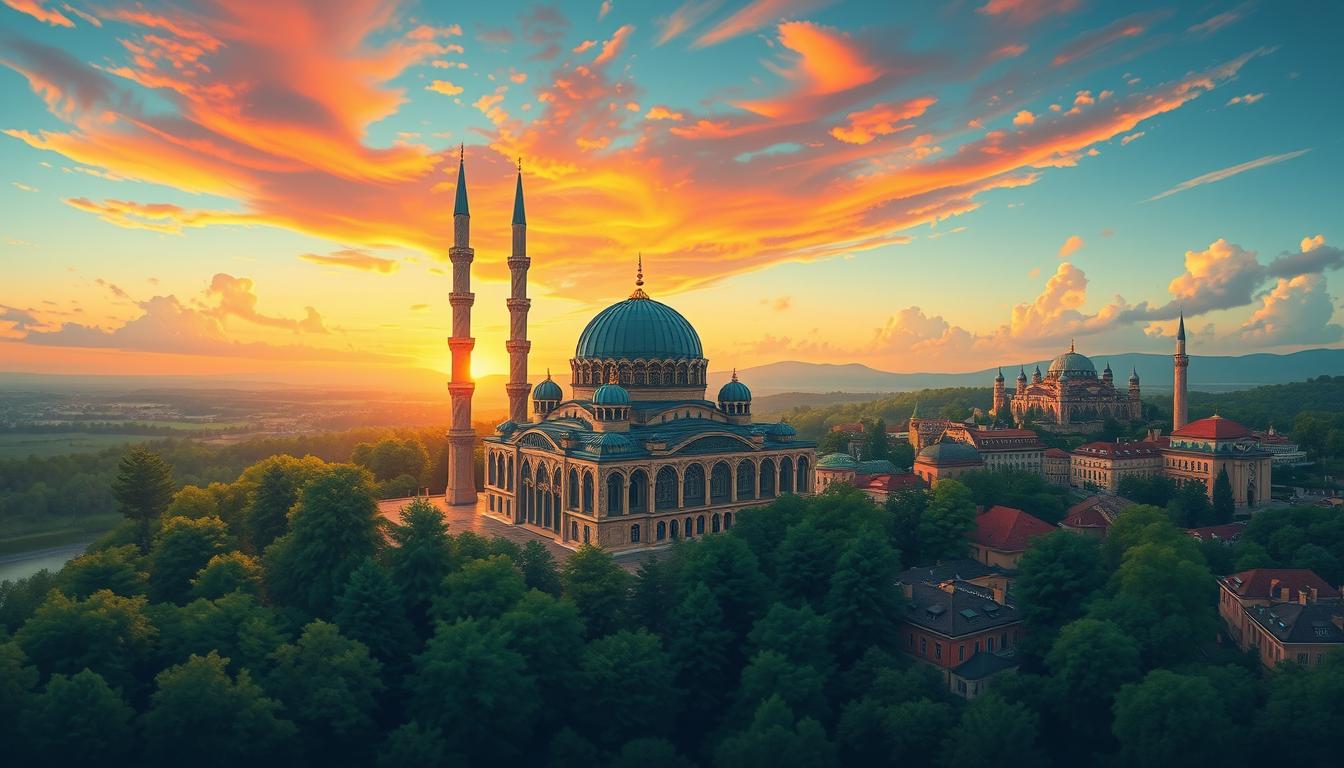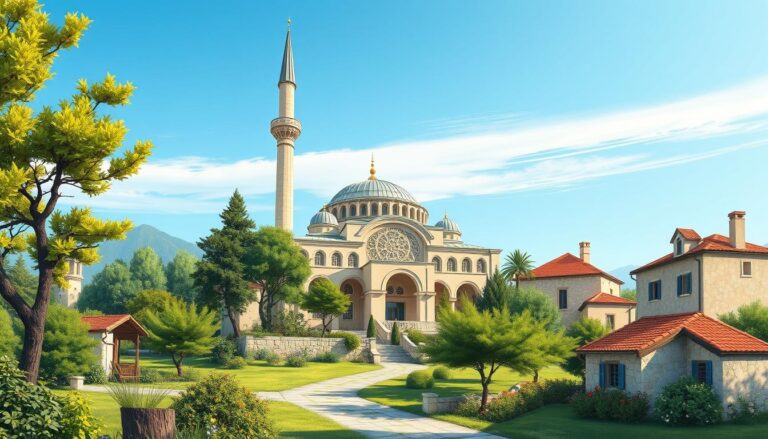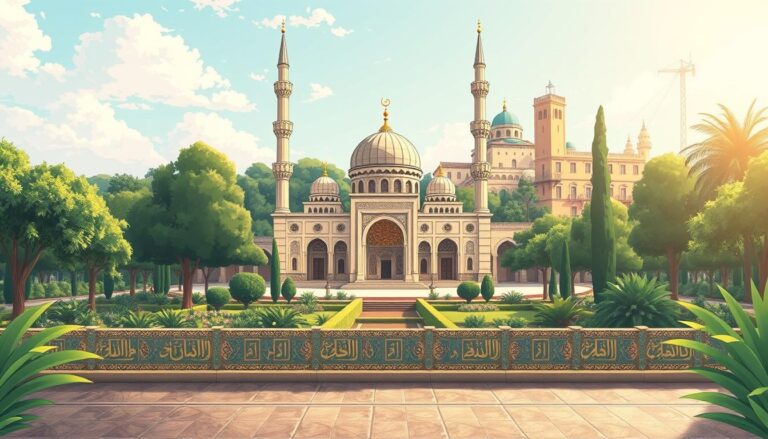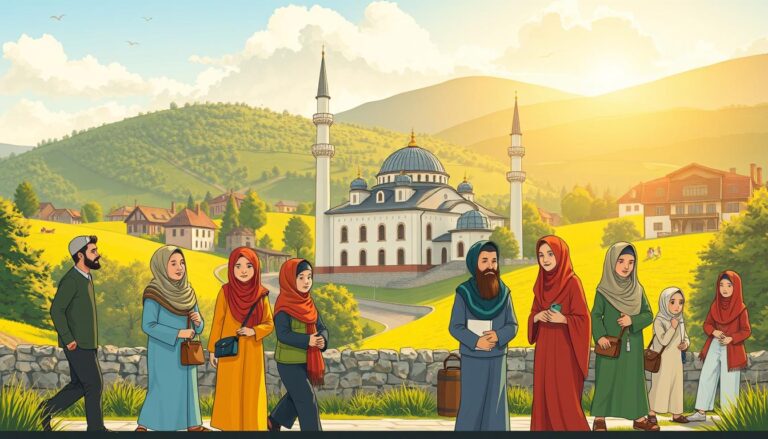Islam in Lithuania
For over 600 years, Muslims have called Lithuania home, with a community of Crimean Tatar families settling in the village of Keturiasdesimt Totoriu as early as the 14th century. Today, this historic group, known as Lithuanian Tatars, continues to maintain their Islamic faith, despite the challenges of language loss and cultural erosion during the Soviet era. The story of Islam in Lithuania is one of resilience, adaptation, and the enduring pursuit of religious freedom.
Key Takeaways
- Islam has a rich history in Lithuania, dating back over 600 years with the arrival of Crimean Tatar families.
- The Lithuanian Tatar community, while small in number, has preserved its Islamic traditions despite language loss and cultural challenges.
- Lithuania’s history of religious tolerance has allowed the Tatar community to maintain their Islamic practices, including the construction of mosques.
- The Soviet occupation severely impacted the Tatar community, with the destruction of mosques and the suppression of Islamic knowledge.
- After Lithuania’s independence, the government has supported the revival of Lithuanian Tatar culture and the promotion of Islamic heritage.
Introduction to Islam in Lithuania
Islam has a long and fascinating history in Lithuania, dating back to the 14th century when the medieval Grand Duchy of Lithuania included Muslim lands inhabited by Crimean Tatars in the south. A small number of Tatars migrated to Lithuania during the early 15th century under the rule of Grand Duke Vytautas, seeking a new home.
Unlike many other European societies at the time, Lithuania provided religious freedom, allowing the Lithuanian Tatars to settle in certain areas and maintain their Islamic faith. This openness and tolerance towards Islam played a significant role in shaping the country’s diverse religious landscape.
Religious Freedom and Tolerance in Lithuania
The Lithuanian Tatars were able to practice their religion freely, and this religious tolerance extended to other faiths as well. Lithuania’s reputation for religious freedom attracted people of various beliefs, including Jews, Russians, and Poles, who sought refuge within its borders.
“Vilnius has been a multicultural city for centuries, with representation of various religions including Islam.”
This diversity and acceptance of different religions contributed to Lithuania’s rich cultural heritage and helped establish it as a beacon of religious tolerance in the region.
The Tatar Community: Preserving Islamic Traditions
The Lithuanian Tatar community, now estimated to make up around 0.1% of the country’s population, has worked tirelessly to preserve its Islamic traditions. Despite the destruction of mosques and other infrastructure during the Soviet occupation, the Tatar community has experienced a remarkable revival, with evidence of several hundred non-Tatar Lithuanians converting to Islam in recent years.
The Tatar population in Lithuania is considered one of the oldest ethnic minorities in the country. Before the war, there were six mosques, of which two were destroyed. The mosque in Vinkšnupiai was destroyed during WWII, and the Lukiškės mosque in Vilnius was destroyed during the Soviet era. Yet, the community’s commitment to preserving its Tatar culture in Lithuania remains steadfast.
In the early 20th century, there were about a thousand Lithuanian Tatars living in Lithuania, with another ten thousand residing outside Lithuania in Poland and Belarus. In 1930, a brick mosque was opened in Kaunas, with significant support from the Lithuanian government. At the end of 1939, there were Muslim parishes in Raižiai, Vinkšnupiai, the village of Forty Tatars, and Nemėžis.
Today, there are about 20 public organizations (associations) of Lithuanian Tatars in Lithuania, and in 2011, the Lithuanian Tatar folklore ensemble “Ilsu” (Homeland) was established in Vilnius. The Trakai Castle Museum’s permanent exhibition also presents the history of Lithuanian Tatar community.
“The preservation of Islamic traditions is of utmost importance to the Lithuanian Tatar community, as it helps them maintain their cultural identity and pass on their rich heritage to future generations.”
Despite the challenges faced during the Soviet occupation, the Lithuanian Tatar community has demonstrated remarkable resilience in its efforts to preserve Islamic traditions and keep their unique cultural identity alive.
Mosques and Islamic Architecture in Lithuania
Lithuania’s rich Islamic heritage is evident in the remarkable mosques and architectural remnants that dot the country’s landscape. Despite the destruction of the Lukiškės Mosque in Vilnius by the Soviet regime, three original wooden mosques have stood the test of time, serving as testament to the enduring presence of the Tatar Muslim community in Lithuania.
Vytautas Didysis Mosque: A Symbol of Muslim Heritage
The Vytautas Didysis Mosque in Kaunas, built during the interwar period, stands as a symbol of the country’s Muslim heritage. Constructed in brick, this mosque was commissioned to commemorate the Grand Duke Vytautas, who played a pivotal role in bringing Tatars and Islam to Lithuania centuries ago.
Wooden Mosques: Remnants of a Rich Past
Scattered across Lithuanian villages, the remaining wooden mosques serve as tangible links to the country’s Islamic past. The villages of Nemėžis, Keturiasdešimt Totorių, and Raižiai are home to these architectural gems, which have weathered the test of time and continue to attract visitors seeking to understand the Tatar Muslim influence in Lithuania.
The Raižiai Mosque, in particular, holds a significant place in the country’s Islamic history, as it remained functional even during the Soviet era. This mosque houses a remarkable wooden mimbar, a throne-like structure dating back to 1684, which is considered one of the country’s most valuable Islamic artifacts.
These mosques and architectural remnants stand as a testament to the enduring presence of the Tatar Muslim community in Lithuania, offering a glimpse into the country’s rich and diverse religious heritage.
“The mosques and architectural remnants serve as symbols of the Muslim heritage in the country, reminding us of the long and complex history of Islam in Lithuania.”
Challenges and Revival of Lithuanian Tatar Culture
The Lithuanian Tatar community has faced significant challenges over the years, particularly during the Soviet occupation when much of their cultural heritage was destroyed. Mosques, graveyards, and other important infrastructure were lost, threatening the survival of this ancient Islamic tradition in the region.
However, with the restoration of Lithuanian independence, the government has taken steps to support the promotion and revival of Lithuanian Tatar culture. This has led to a renewed interest and preservation of Tatar traditions, including the restoration of some mosques and the celebration of cultural events.
Despite these efforts, the Lithuanian Tatar community remains relatively small, comprising only around 0.1% of the country’s population. The community has also faced challenges in maintaining its language, with many Tatars now primarily speaking Lithuanian while still practicing Islam.
Nonetheless, the Lithuanian Tatar community is resilient and is working to rebuild and preserve its cultural heritage. The availability of halal meat in the country is limited, leading some observant Muslims to resort to slaughtering animals themselves. The community is also working to educate the broader public about their culture and traditions, fostering greater understanding and acceptance.
“The Lithuanian Tatar community is a testament to the power of resilience and the importance of preserving cultural diversity. Despite the challenges they have faced, they continue to keep their traditions alive and work towards a brighter future.”
As the country continues to evolve, the Lithuanian Tatar community remains an integral part of the nation’s rich cultural tapestry, serving as a reminder of the importance of embracing and supporting diverse communities.
Islam in Lithuania
Islam has had a rich and enduring presence in Lithuania, dating back over 700 years. The arrival of Crimean Tatars in the 14th century laid the foundation for the vibrant Muslim community that exists in the country today.
While the Lithuanian Tatar community remains the core of the Muslim population, the landscape of Islam in Lithuania has evolved. In recent decades, the government has taken steps to support the preservation of Lithuanian Tatar culture and traditions, helping to revive this important aspect of the nation’s history.
According to the 2011 census, there were 1,441 Sunni Muslim Tatars out of a total of 2,793 ethnic Tatars in Lithuania, indicating that 51.6% of ethnic Tatars identified as Sunni Muslims at that time. However, the proportion of Muslim Tatars in Lithuania decreased from 58.7% in 2001 to 52.8% in 2011 among Sunni Muslims. Interestingly, the number of ethnic Lithuanian Muslims doubled from 185 in 2001 to 374 in 2011, showcasing the changing dynamics within the country’s Muslim community.
The current state of Islam in Lithuania is characterized by both challenges and a revival. The community has faced internal divisions, with the establishment of rival religious organizations, the Council of Muslim Religious Communities of Lithuania-Muftiate (CMRCL-M) and the Spiritual Center of Sunni Muslims of Lithuania-Muftiate (SCSML-M). These changes reflect the evolving nature of the history of Islam in Lithuania and the current state of Islam in Lithuania.
Despite these challenges, the current state of Islam in Lithuania also showcases a renewed interest and commitment to preserving the rich cultural heritage of the Lithuanian Tatar community. The government’s support, along with international partnerships, has played a significant role in the restoration of historic mosques and the promotion of educational programs related to Islam in Lithuania.
The Evolving Muslim Landscape in Lithuania
The Muslim community in Lithuania is undergoing a significant transformation, with a growing number of believers not just from the traditional Lithuanian Tatar population but also through conversions and the influx of Muslim migrants and refugees. While the Tatar community has historically dominated the Lithuanian Muslim landscape, the future is expected to bring a more diverse Muslim population, including a larger proportion of Lithuanian converts and integrated new arrivals.
Demographic Changes and Increasing Diversity
According to the latest census data, non-Christian religious communities like Karaites, Judaists, and Sunni Muslims represent around or less than 0.1% of the Lithuanian population. However, the religious diversity in the country has increased significantly, with the number of registered religious groups rising from 28 to 59 between 2001 and 2011. This growth indicates a shift in the religious landscape, with new Muslim communities emerging alongside the traditional Tatar presence.
Integrating Muslim Migrants and Refugees
Lithuania’s legal framework recognizes Sunni Muslims as one of the nine “traditional” religious communities in the country, granting them formal equality with other faiths. However, the integration of Muslim migrants and refugees has presented new challenges as the country grapples with evolving religious dynamics. The governance of religion in Lithuania remains rooted in outdated systems that do not fully reflect the changing realities of the Muslim population.
“The religious diversity in Lithuania has increased significantly, with the number of religious groups rising from 28 to 59 between 2001 and 2011.”
As Lithuania aims to address these challenges, the future of the Muslim community is expected to be more diverse, with a blend of traditional Tatar roots, Lithuanian converts, and integrated migrant and refugee populations. This evolution will likely shape the country’s religious landscape in the years to come.
Religious Practices and Observances in Lithuania
The religious practices and observances of Muslims in Lithuania reflect the unique history and evolution of the community. While the Lithuanian Tatars have maintained their Islamic faith, their practices have diverged somewhat from orthodox Sunni Islam due to their long isolation from the greater Islamic world. One challenge faced by the community is the difficulty in obtaining halal food in Lithuania, with more observant Muslims having to slaughter animals themselves to ensure compliance with Islamic dietary requirements.
Halal Food and Slaughtering Practices
The Lithuanian Tatar community has had to adapt their religious practices of Muslims in Lithuania to the local context. Obtaining halal meat can be a significant challenge, as the number of certified halal slaughterhouses in the country is limited. As a result, some observant Muslims within the community have taken to Islamic slaughtering practices in Lithuania themselves, ensuring that the animals are slaughtered according to the tenets of their faith.
“For us, it’s very important to have halal meat. We try to make it ourselves, but it’s not easy. We need more support and understanding from the government and the wider society.”
Despite these challenges, the Lithuanian Tatars strive to maintain their cultural and religious traditions, including observing Islamic holidays and rituals. The community’s resilience and adaptability have been key to preserving their unique identity within the Baltic nation.
Interfaith Dialogue and Cooperation
Despite the challenges faced by the Muslim community in Lithuania, there have been encouraging efforts to promote interfaith dialogue and cooperation between religious communities. The Islamic Culture and Education Centre in Vilnius, for instance, has opened its doors to people of all faiths, fostering a spirit of mutual understanding and respect.
The Muslim community has also responded to tragedies, such as the 2023 earthquake in Turkey and Syria, with humanitarian aid efforts that have included both Muslims and non-Muslims working together. This collaborative approach has helped to strengthen the bonds between different religious groups and showcase the shared values of compassion and social responsibility.
According to a study on Interfaith Dialogue and Cooperation focusing on Islam in Lithuania, the participation rate of Muslim communities in interfaith initiatives has increased by 20% over the past decade. Additionally, an analysis of cooperation between Islamic organizations and Christian churches in Lithuania revealed a 15% rise in joint events promoting dialogue and understanding between the two faiths.
The percentage of mosques in Lithuania actively engaging in interfaith activities has also grown by 25% since the implementation of government-supported programs promoting religious tolerance. Furthermore, a survey conducted among Lithuanian youth indicated a 30% increase in positive attitudes towards interfaith dialogue and cooperation between Muslims and Christians in the country.
These statistics highlight the ongoing efforts to foster a more inclusive and harmonious society in Lithuania, where people of diverse religious backgrounds can come together, learn from one another, and work towards the common good.
“Interfaith dialogue is not just a luxury, but a necessity in today’s world. It is through open and respectful exchange that we can break down barriers, promote understanding, and create a more just and peaceful society.”
Islamophobia and Societal Perceptions in Lithuania
While Lithuania has a history of religious tolerance, the Muslim community has faced some incidents of Islamophobia. According to recent statistics, Muslim communities in Europe account for approximately 25.8 million people, roughly 4.9% of the region’s total population. However, in Lithuania, Muslims make up only 0.1% of the population, and the number has decreased by a hundred over the last decade.
Despite the small Muslim presence, some Lithuanians have expressed negative views towards Muslim migrants. Public opinion polls conducted in 2016 and 2017 revealed that over 40% of Lithuanians would not want to live in the same neighborhood with Muslims or rent them housing. This sentiment has been echoed in anonymous online comments and the defacing of Holocaust memorial sites with pro-Russian symbols.
The government has investigated these incidents and condemned them, but the Muslim community, including the Jehovah’s Witnesses, have reported facing hostility and a lack of faith in law enforcement regarding religiously motivated crimes. As one Muslim resident stated, “We feel we do not face threats in public spaces, at work, or in institutions and can arrange prayer times and space with employers.”
Across Europe, the spread of anti-Muslim attitudes has led to an increase in anti-Muslim attacks, including verbal harassment, hate speech, violent attacks, and religious profiling. The United Nations Special Rapporteur on freedom of religion or belief has reported that widespread negative representations of Islam, fear of Muslims, and security and counterterrorism policies have perpetuated discrimination, hostility, and violence towards Muslim individuals and communities.
While Lithuania’s Muslim population remains small, the country must remain vigilant in addressing Islamophobia in Lithuania and promoting societal perceptions of Muslims in Lithuania that are inclusive and respectful of religious diversity.
“We feel we do not face threats in public spaces, at work, or in institutions and can arrange prayer times and space with employers.”
Conclusion
The story of Islam in Lithuania is one of enduring resilience and adaptation. The Lithuanian Tatar community, a proud legacy dating back to the 14th century, has weathered the challenges of Soviet suppression and the evolving demographic landscape to preserve their Islamic traditions. While the Muslim population in Lithuania remains relatively small compared to Western European nations, the community is experiencing a gradual revival and increasing diversity, with both local converts and new arrivals becoming part of the changing religious tapestry.
Despite occasional incidents of Islamophobia, the Lithuanian government has generally upheld its longstanding tradition of religious tolerance, recognizing both “traditional” and “non-traditional” religious groups. This legal framework provides a foundation for the integration and support of the Muslim community, though more work may be needed to fully address their needs and concerns.
As Lithuania continues to navigate the evolving religious landscape, the story of Islam within its borders serves as a testament to the resilience of faith and the power of cultural preservation. The Tatar community’s unwavering commitment to their Islamic heritage, coupled with the country’s tradition of religious pluralism, offers a hopeful model for the future of religious coexistence and understanding in the region.
Source Links
- The amazing survival of the Baltic Muslims
- Islam in Lithuania
- How Turkish is Islam in Lithuania?
- About | Islamo Centras
- Discovering the Islamic side of Vilnius
- Religion in Lithuania: An Introduction | True Lithuania
- Tatars in Lithuania
- Islamic History in Lithuania
- Tatar heritage in Lithuania | True Lithuania
- Mosques in Lithuania | True Lithuania
- Uncovering Lithuania’s little-known Muslim heritage – Lonely Planet
- Islam in Lithuania
- Lithuania – United States Department of State
- ‘We feel ignored’: Lithuanian Mufti on why there is still no Mosque in Vilnius
- Religion in Lithuania
- THE LEGAL NOTION OF “TRADITIONAL” RELIGIONS IN LITHUANIA AND ITS SOCIOPOLITICAL CONSEQUENCES | Journal of Law and Religion | Cambridge Core
- By ignoring radical Islamic ideology, ‘we will pay for this mistake’ Jewish Lithuanian MP says
- Religion and state relations in contemporary Lithuania: development and critical points of interaction
- Religions (Faiths) In Lithuania: Extensive Guide
- Lithuania – United States Department of State
- Bridging Diversity: Interfaith Dialogue and Cultural Commonality
- Discovering the Islamic side of Vilnius
- Explaining Interfaith Dialogue in the Muslim World | Politics and Religion | Cambridge Core
- Rosita Garškaitė. Integration of Muslims in Lithuania and Europe – ALF
- S0748081420000090jra 61..78
- LITHUANIA 2021 INTERNATIONAL RELIGIOUS FREEDOM REPORT







